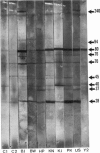Abstract
Sera from patients with Plasmodium falciparum, P. vivax or P. ovale malaria were selected according to their high levels of antibodies against human erythrocyte membranes as measured in a microELISA. The specificity of the anti-erythrocyte antibodies in these sera and two normal sera was investigated by means of an immunoblotting technique in combination with SDS-polyacrylamide gel electrophoresis. All the patients' sera as well as the control sera contained antibodies against several erythrocyte polypeptides. As compared with normal sera, most malaria sera showed elevated levels of antibodies against polypeptides of 80K, 70K, 40K and 28K molecular weights. Two sera reacted strongly against a polypeptide with an electrophoretic mobility similar to the alpha subunit of spectrin. One serum showed strong reaction and several other sera, including normal sera, showed weak reaction against a 45K molecular weight polypeptide corresponding to actin. No pervading differences were seen in the pattern of specificities of the anti-erythrocyte ghost antibodies between sera from patients with P. falciparum, P. vivax or P. ovale infections.
Full text
PDF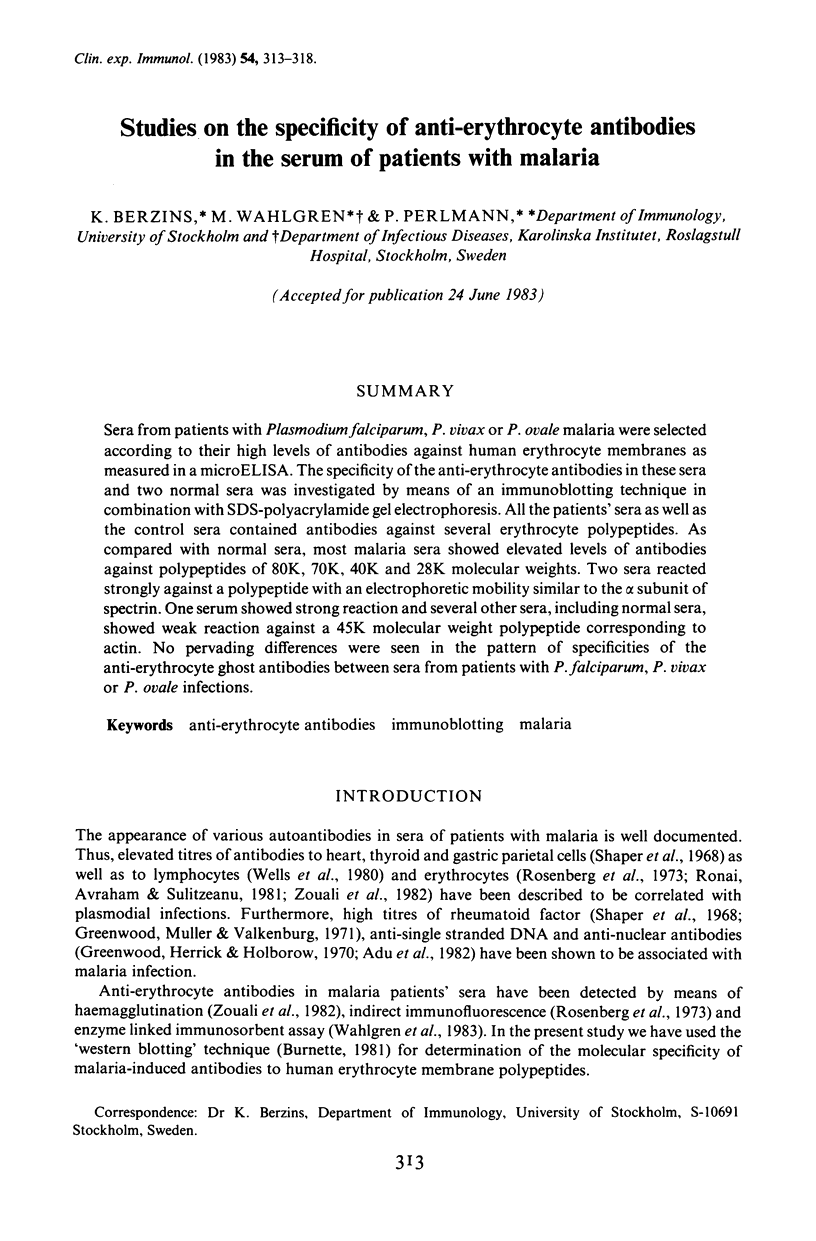
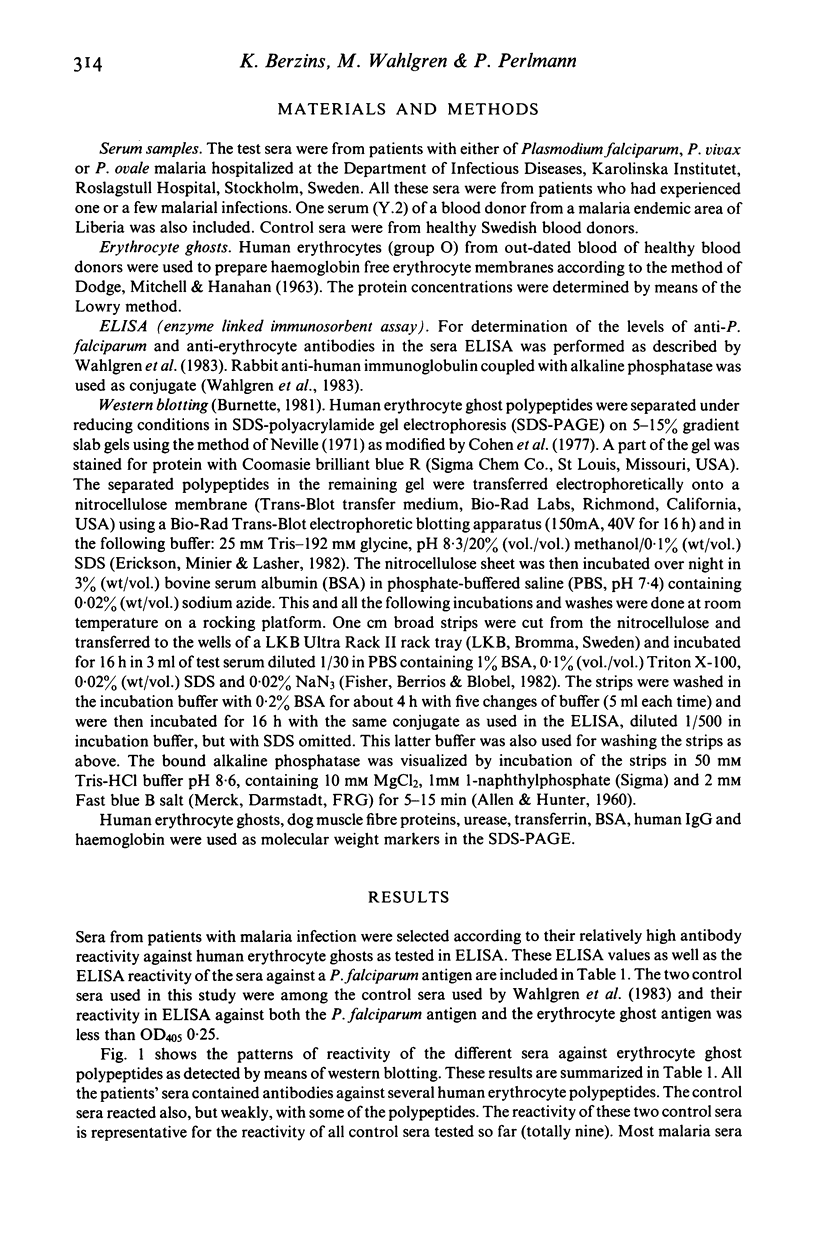
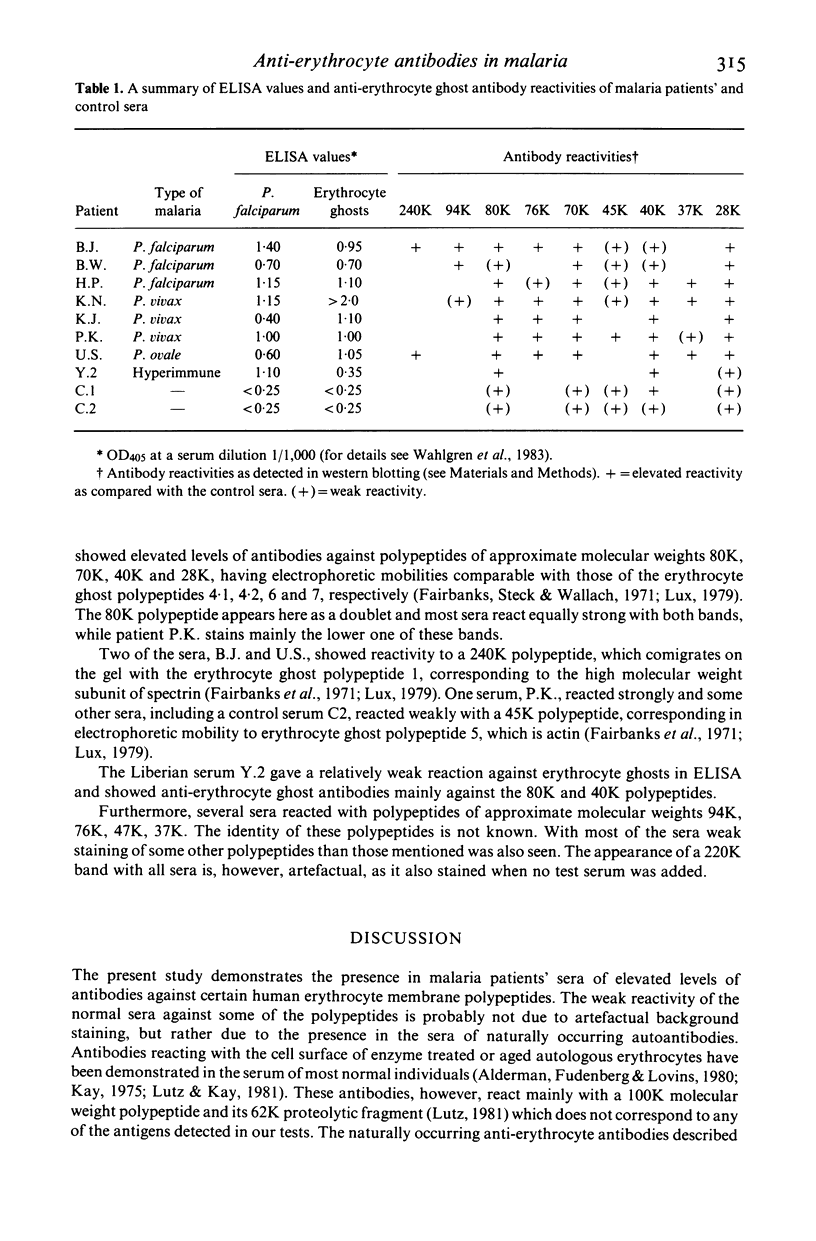
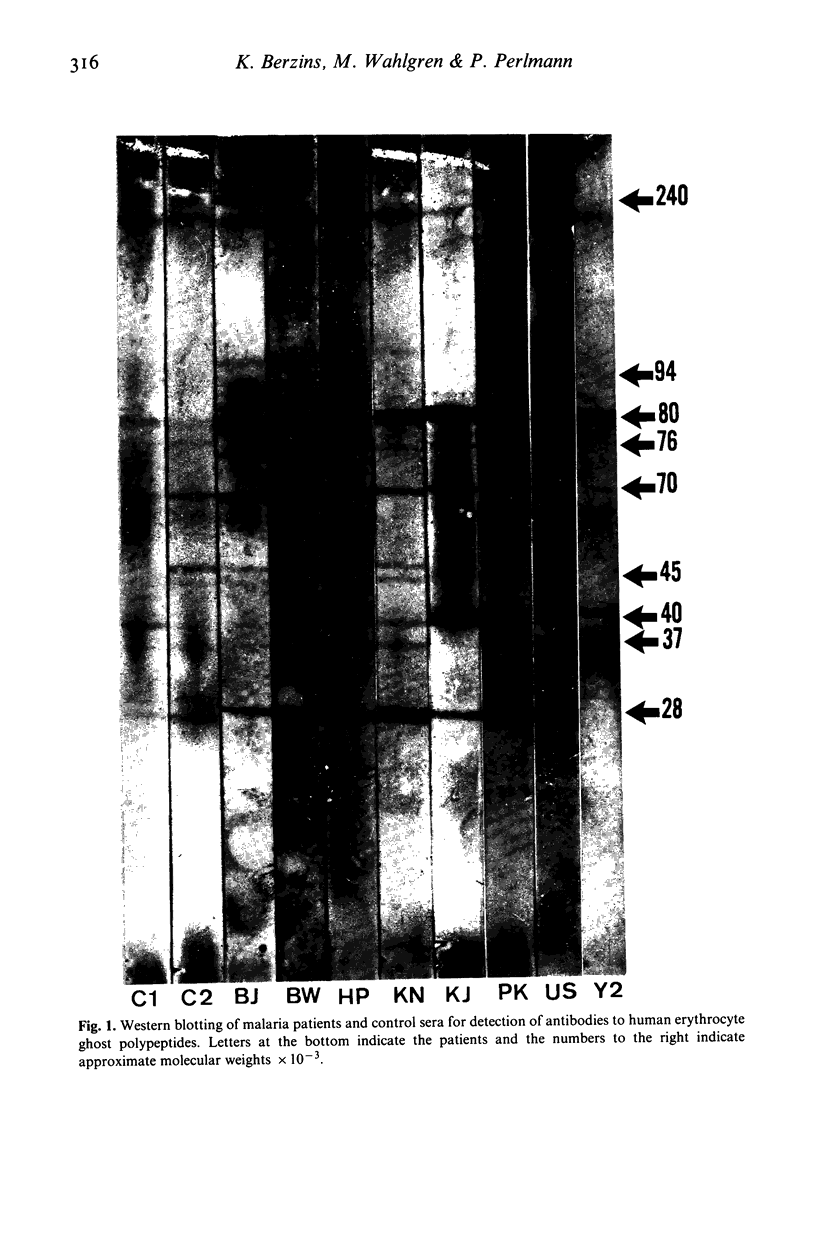
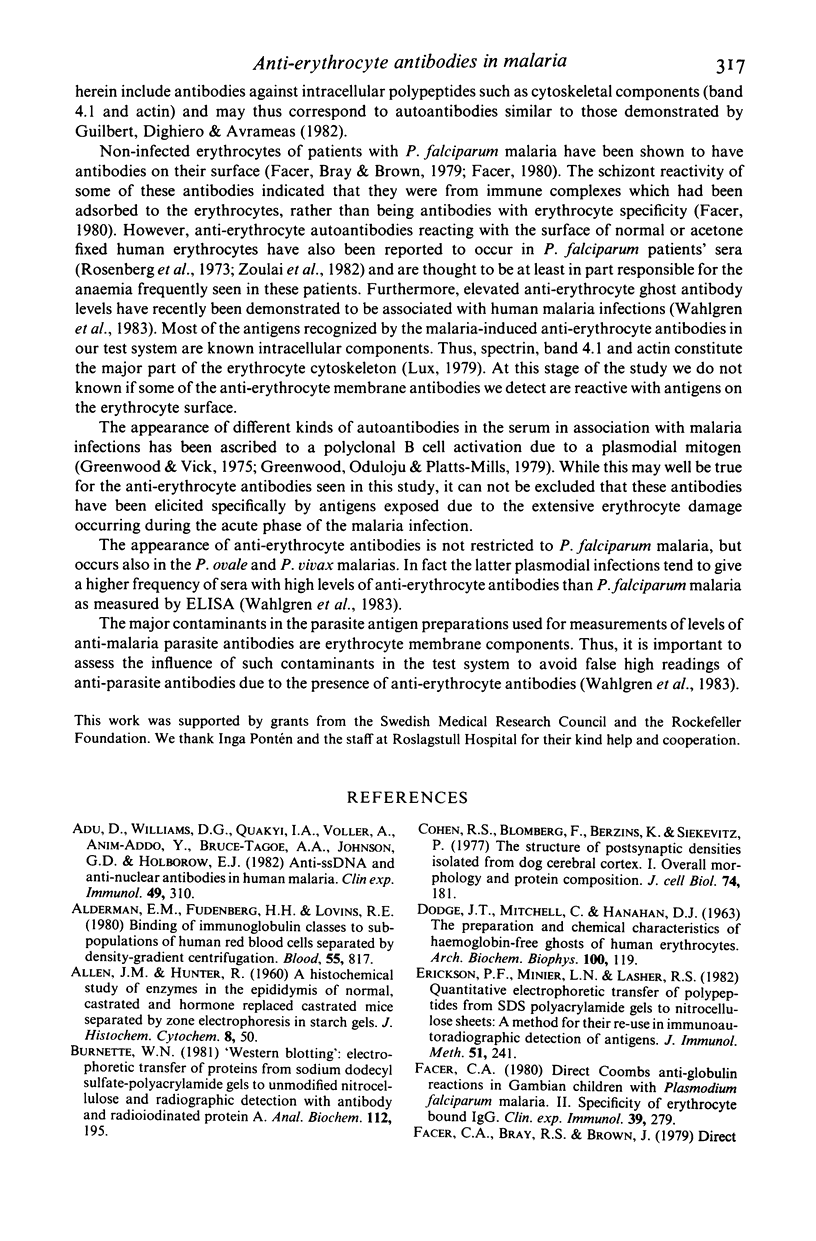
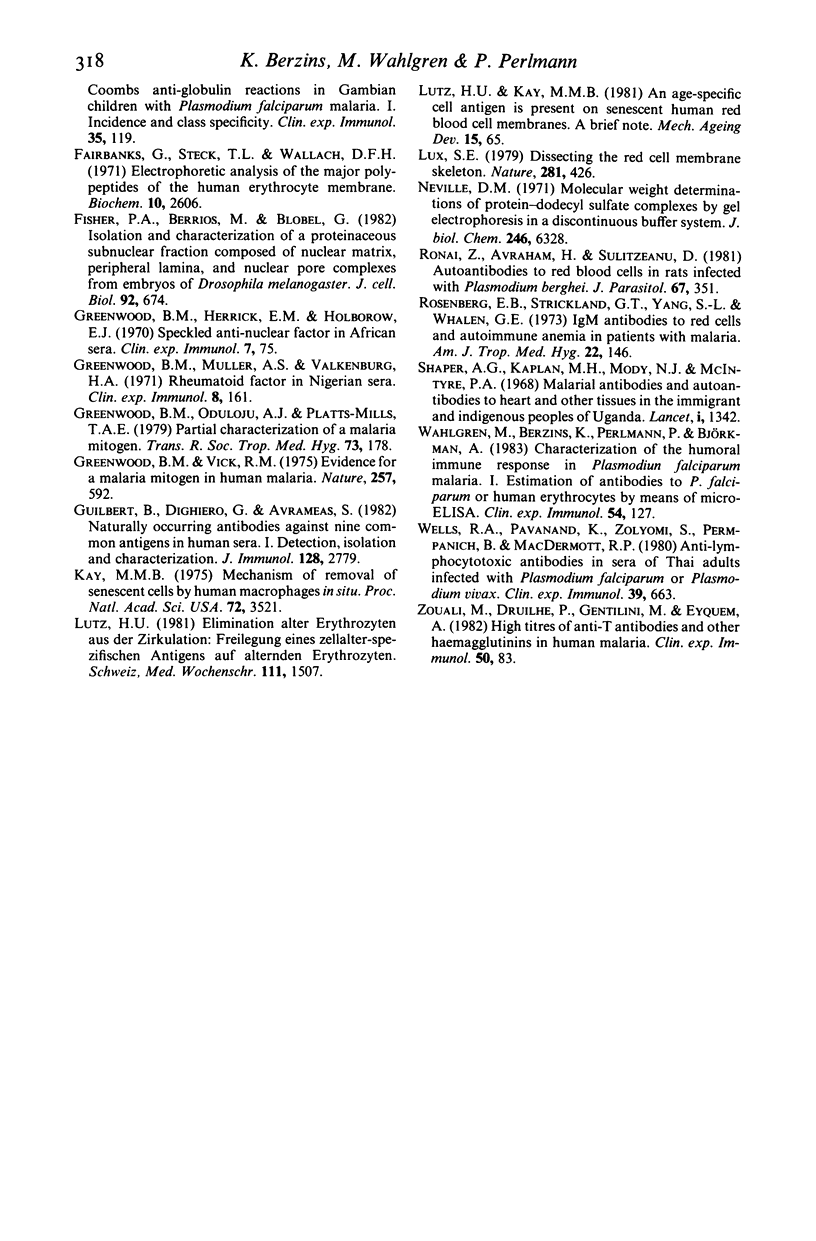
Images in this article
Selected References
These references are in PubMed. This may not be the complete list of references from this article.
- ALLEN J. M., HUNTER R. L. A histochemical study of enzymes in the epididymis of normal, castrated and hormone replaced castrated mice separated by zone electrophoresis in starch gels. J Histochem Cytochem. 1960 Jan;8:50–57. doi: 10.1177/8.1.50. [DOI] [PubMed] [Google Scholar]
- Adu D., Williams D. G., Quakyi I. A., Voller A., Anim-Addo Y., Bruce-Tagoe A. A., Johnson G. D., Holborow E. J. Anti-ssDNA and antinuclear antibodies in human malaria. Clin Exp Immunol. 1982 Aug;49(2):310–316. [PMC free article] [PubMed] [Google Scholar]
- Alderman E. M., Fudenberg H. H., Lovins R. E. Binding of immunoglobulin classes to subpopulations of human red blood cells separated by density-gradient centrifugation. Blood. 1980 May;55(5):817–822. [PubMed] [Google Scholar]
- Burnette W. N. "Western blotting": electrophoretic transfer of proteins from sodium dodecyl sulfate--polyacrylamide gels to unmodified nitrocellulose and radiographic detection with antibody and radioiodinated protein A. Anal Biochem. 1981 Apr;112(2):195–203. doi: 10.1016/0003-2697(81)90281-5. [DOI] [PubMed] [Google Scholar]
- Cohen R. S., Blomberg F., Berzins K., Siekevitz P. The structure of postsynaptic densities isolated from dog cerebral cortex. I. Overall morphology and protein composition. J Cell Biol. 1977 Jul;74(1):181–203. doi: 10.1083/jcb.74.1.181. [DOI] [PMC free article] [PubMed] [Google Scholar]
- Erickson P. F., Minier L. N., Lasher R. S. Quantitative electrophoretic transfer of polypeptides from SDS polyacrylamide gels to nitrocellulose sheets: a method for their re-use in immunoautoradiographic detection of antigens. J Immunol Methods. 1982 Jun 11;51(2):241–249. doi: 10.1016/0022-1759(82)90263-0. [DOI] [PubMed] [Google Scholar]
- Facer C. A., Bray R. S., Brown J. Direct Coombs antiglobulin reactions in Gambian children with Plasmodium falciparum malaria. I. Incidence and class specificity. Clin Exp Immunol. 1979 Jan;35(1):119–127. [PMC free article] [PubMed] [Google Scholar]
- Facer C. A. Direct Coombs antiglobulin reactions in Gambian children with Plasmodium falciparum malaria. II. Specificity of erythrocyte-bound IgG. Clin Exp Immunol. 1980 Feb;39(2):279–288. [PMC free article] [PubMed] [Google Scholar]
- Fairbanks G., Steck T. L., Wallach D. F. Electrophoretic analysis of the major polypeptides of the human erythrocyte membrane. Biochemistry. 1971 Jun 22;10(13):2606–2617. doi: 10.1021/bi00789a030. [DOI] [PubMed] [Google Scholar]
- Fisher P. A., Berrios M., Blobel G. Isolation and characterization of a proteinaceous subnuclear fraction composed of nuclear matrix, peripheral lamina, and nuclear pore complexes from embryos of Drosophila melanogaster. J Cell Biol. 1982 Mar;92(3):674–686. doi: 10.1083/jcb.92.3.674. [DOI] [PMC free article] [PubMed] [Google Scholar]
- Greenwood B. M., Herrick E. M., Holborow E. J. Speckled antinuclear factor in African sera. Clin Exp Immunol. 1970 Jul;7(1):75–83. [PMC free article] [PubMed] [Google Scholar]
- Greenwood B. M., Muller A. S., Valkenburg H. A. Rheumatoid factor in Nigerian sera. Clin Exp Immunol. 1971 Aug;9(2):161–173. [PMC free article] [PubMed] [Google Scholar]
- Greenwood B. M., Oduloju A. J., Platts-Mills T. A. Partial characterization of a malaria mitogen. Trans R Soc Trop Med Hyg. 1979;73(2):178–182. doi: 10.1016/0035-9203(79)90204-9. [DOI] [PubMed] [Google Scholar]
- Greenwood B. M., Vick R. M. Evidence for a malaria mitogen in human malaria. Nature. 1975 Oct 16;257(5527):592–594. doi: 10.1038/257592a0. [DOI] [PubMed] [Google Scholar]
- Guilbert B., Dighiero G., Avrameas S. Naturally occurring antibodies against nine common antigens in human sera. I. Detection, isolation and characterization. J Immunol. 1982 Jun;128(6):2779–2787. [PubMed] [Google Scholar]
- Kay M. M. Mechanism of removal of senescent cells by human macrophages in situ. Proc Natl Acad Sci U S A. 1975 Sep;72(9):3521–3525. doi: 10.1073/pnas.72.9.3521. [DOI] [PMC free article] [PubMed] [Google Scholar]
- Lutz H. U. Elimination alter Erythrozyten aus der Zirkulation: Freilegung eines zellater-spezifischen Antigens auf alternden Erythrozyten. Schweiz Med Wochenschr. 1981 Oct 10;111(41):1507–1517. [PubMed] [Google Scholar]
- Lutz H. U., Kay M. M. An age-specific cell antigen is present on senescent human red blood cell membranes. A brief note. Mech Ageing Dev. 1981 Jan;15(1):65–75. doi: 10.1016/0047-6374(81)90008-7. [DOI] [PubMed] [Google Scholar]
- Lux S. E. Dissecting the red cell membrane skeleton. Nature. 1979 Oct 11;281(5731):426–429. doi: 10.1038/281426a0. [DOI] [PubMed] [Google Scholar]
- Neville D. M., Jr Molecular weight determination of protein-dodecyl sulfate complexes by gel electrophoresis in a discontinuous buffer system. J Biol Chem. 1971 Oct 25;246(20):6328–6334. [PubMed] [Google Scholar]
- Ronai Z., Avraham H., Sulitzeanu D. Autoantibodies to red blood cells in rats infected with Plasmodium berghei. J Parasitol. 1981 Jun;67(3):351–354. [PubMed] [Google Scholar]
- Rosenberg E. B., Strickland G. T., Yang S. L., Whalen G. E. IgM antibodies to red cells and autoimmune anemia in patients with malaria. Am J Trop Med Hyg. 1973 Mar;22(2):146–152. doi: 10.4269/ajtmh.1973.22.146. [DOI] [PubMed] [Google Scholar]
- Shaper A. G., Kaplan M. H., Mody N. J., McIntyre P. A. Malarial antibodies and autoantibodies to heart and other tissues in the immigrant and indigenous peoples of Uganda. Lancet. 1968 Jun 22;1(7556):1342–1346. doi: 10.1016/s0140-6736(68)92037-0. [DOI] [PubMed] [Google Scholar]
- Wahlgren M., Berzins K., Perlmann P., Björkman A. Characterization of the humoral immune response in Plasmodium falciparum malaria. I. Estimation of antibodies to P. falciparum or human erythrocytes by means of microELISA. Clin Exp Immunol. 1983 Oct;54(1):127–134. [PMC free article] [PubMed] [Google Scholar]
- Wells R. A., Pavanand K., Zolyomi S., Permpanich B., Macdermott R. P. Anti-lymphocytotoxic antibodies in sera of Thai adults infected with Plasmodium falciparum or Plasmodium vivax. Clin Exp Immunol. 1980 Mar;39(3):663–667. [PMC free article] [PubMed] [Google Scholar]
- Zouali M., Druilhe P., Gentilini M., Eyquem A. High titres of anti-T antibodies and other haemagglutinins in human malaria. Clin Exp Immunol. 1982 Oct;50(1):83–91. [PMC free article] [PubMed] [Google Scholar]



